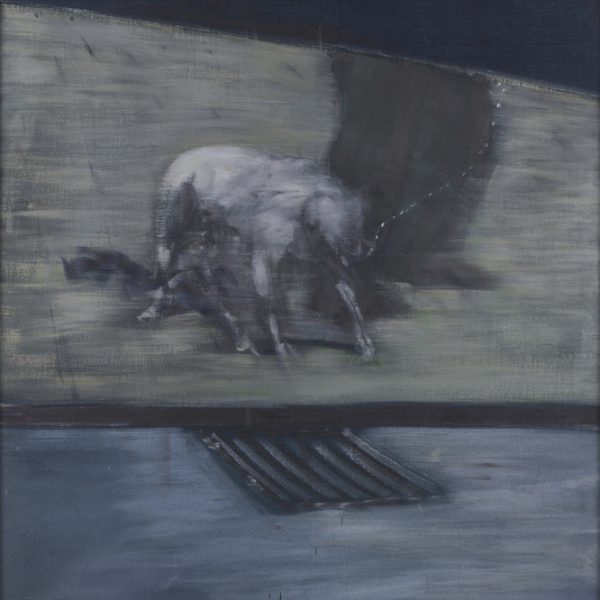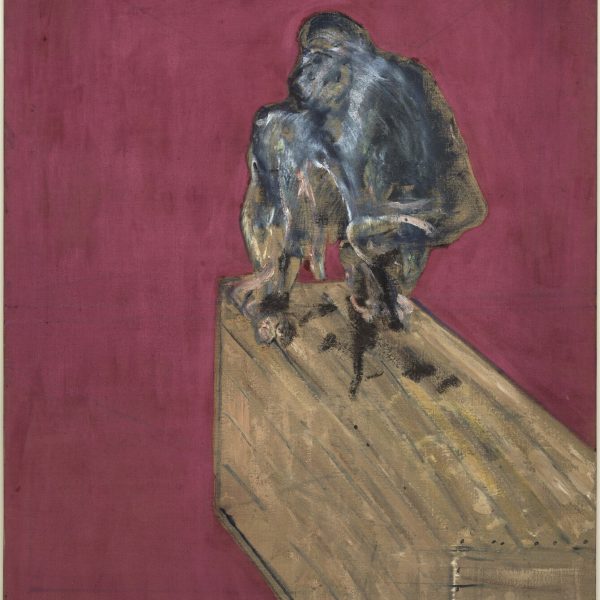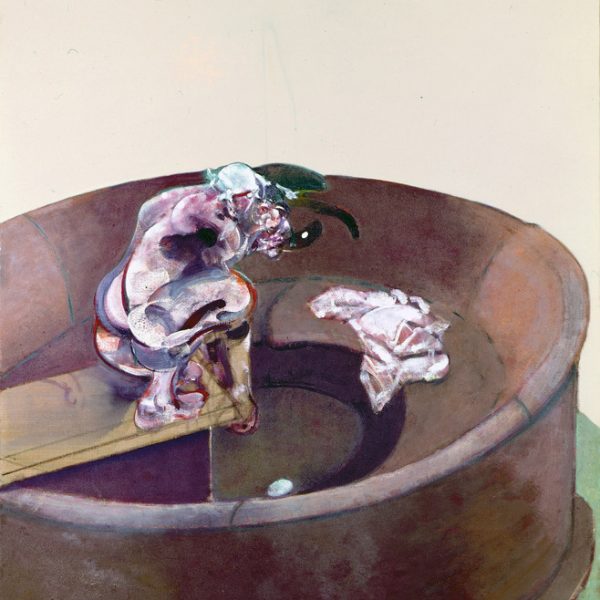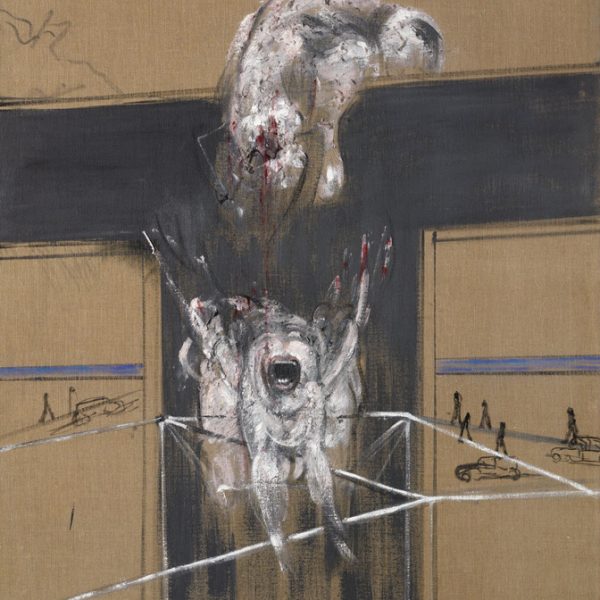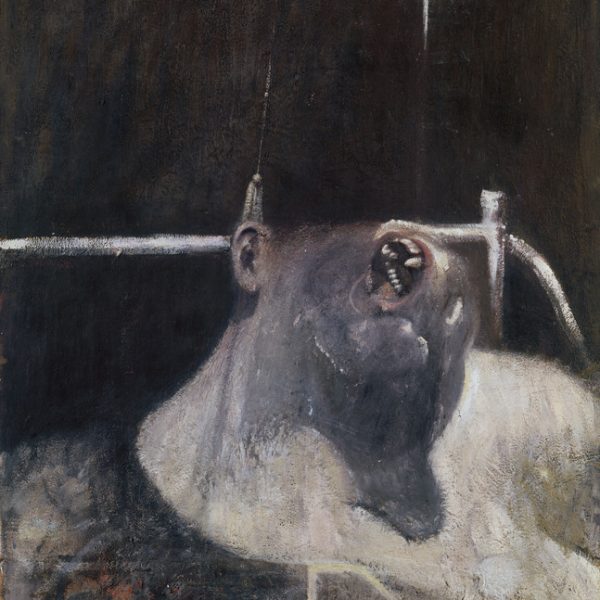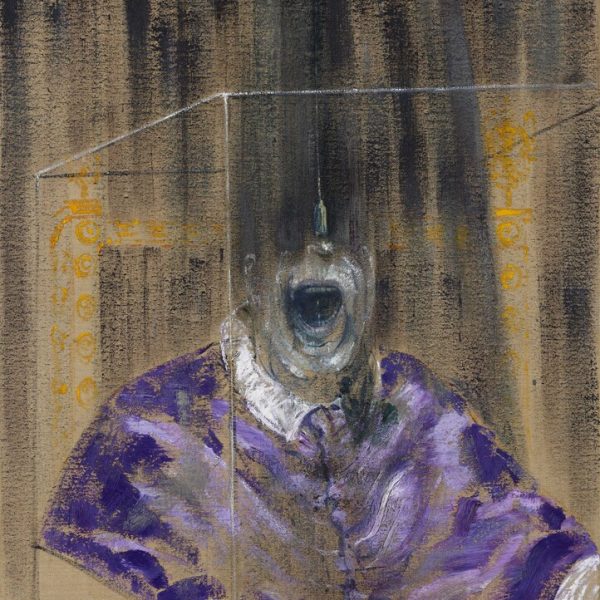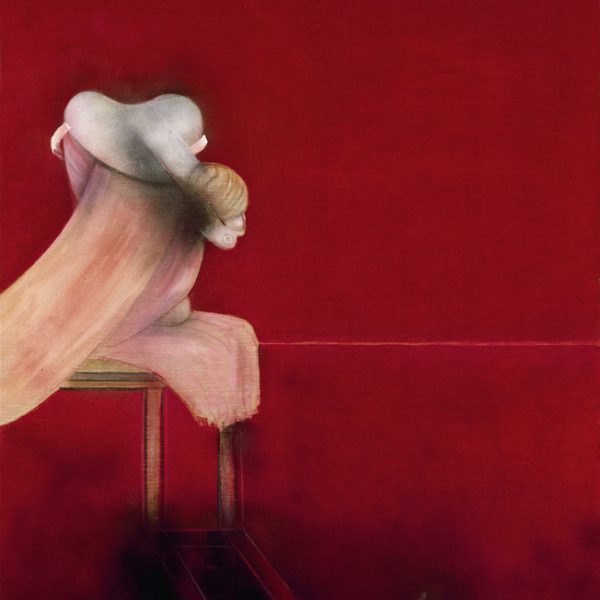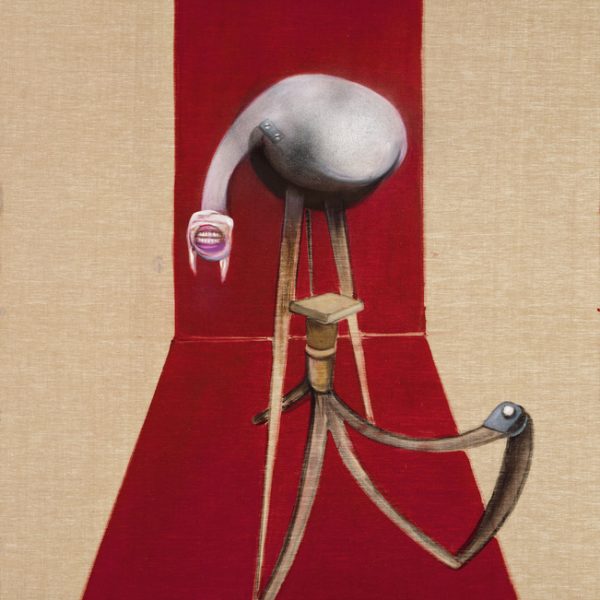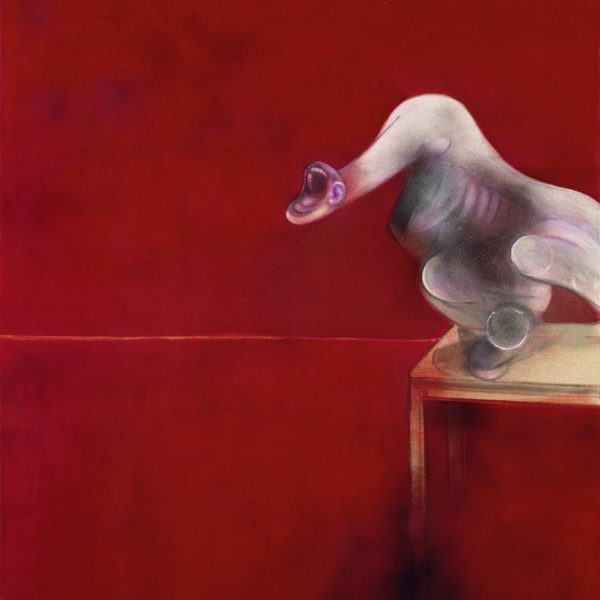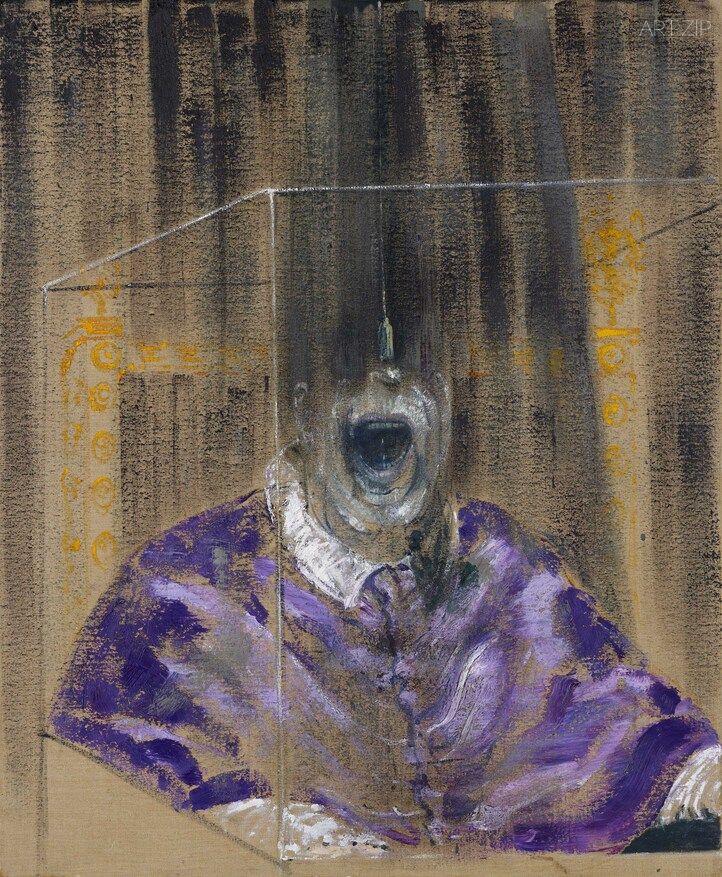
Royal Academy of Arts, Main Galleries
Saturday 29 January – Sunday 17 April 2022
The Royal Academy of Arts presents Francis Bacon: Man and Beast, the first exhibition to chart the development of the artist’s work through the lens of his fascination with animals, and how this impacted upon his treatment of his ultimate subject: the human figure. Francis Bacon (1909–1992) is recognised as one of the most important artists of the twentieth century. Since his death, the world has changed in ways that make his unnerving work ever more prescient. This important exhibition includes 46 remarkable paintings spanning his career; from his earliest works of the 1930s and 40s through to the final painting he ever made in 1991, which is exhibited publicly for the first time in the UK. Among the works, a trio of paintings of bullfights, all made in 1969, are displayed together for the first time.
In Bacon’s paintings, man is never far from beast. That humankind is fundamentally an animal was a truth that lay at the heart of his imagery. From the biomorphic creatures of his earliest work, to the distorted nudes that define the latter part of his career, Bacon remained convinced that, beneath the veneer of civilisation, humans are animals like any other. Throughout his life, the artist was captivated by the movement of animals, tracking them on trips to South Africa and amassing a vast collection of wildlife books. By observing their uninhibited behaviour, he believed he could get closer to the core of humanity.
Broadly chronological, the exhibition begins with a group of paintings of biomorphic creatures produced between 1944 and 1946 which suggest a disintegration of civilised humanity. One of Bacon’s earliest surviving works, Crucifixion, 1933 (Private Collection), and in the later Fragment of a Crucifixion, 1950 (Van Abbemuseum, Eindhoven), is displayed in this gallery. The following section explores Bacon’s interest in observing animals and portraiture, which was central to Bacon’s exploration of the boundaries between the human and non-human animal. In preparation for his first solo exhibition in 1949, the artist produced a series of six Heads – unsettling portraits in which not only identity, but species, is called into question. The characters are placed in cuboid structures, a compositional device that appeared here for the first time and would come to define Bacon’s work. Head I, 1949 (Metropolitan Museum of Art), displayed at the start of the exhibition. And Head VI (Arts Council Collection, Southbank Centre, London) marks Bacon’s first portrait after Diego Velázquez’s Portrait of Pope Innocent X. Two other subversions of Velázquez’s Pope are displayed.
The movement of human and animal bodies, and how it could distinguish or conflate them, are the subject of the next gallery. Exemplified by Paralytic Child Walking on All Fours (from Muybridge), 1961 (Kunstmuseum Den Haag, donation private collection in 1964). Two Figures, 1953 (Private Collection), sexualises the sporting scene in a daring affront to the law.
The next section demonstrates Bacon’s subversion of traditional representations of the nude from the 1960s onwards. For examples, Portrait of Henrietta Moraes on a Blue Couch, 1965 (Manchester Art Gallery, Manchester) and Triptych – Studies of the Human Body, 1970 (Private Collection). At the centre of the exhibition is a powerful trio of paintings of bullfights that present one of the most direct encounters between man and beast in Bacon’s oeuvre. Displayed together in this exhibition for the very first time, the paintings of the corrida highlight the fine lines between flesh and meat, violence and eroticism, life and death. These three two-metre high paintings communicate the fragility of man’s supposed superiority over animals.
The following section focuses on Bacon’s lover and muse, and one of the most consistent but enigmatic motifs in Bacon’s works — the ‘Furies’. Here demonstrates Triptych Inspired by the Oresteia of Aeschylus, 1981 (Private Collection). This is the only painting in which the Greek playwright is referenced by name. Deep red dominates all three panels of the other triptych in this room, Second Version of Triptych 1944, 1988 (Tate, London) in which Bacon returns to the ‘Furies’ of his works of the mid-1940s.
The exhibition concludes with the last painting Bacon ever made, Study of a Bull, 1991 (Private Collection), which was not discovered until 2016. The bull emerges from the picture as if about to charge, but the black void behind has opened to claim it forever.
展覽地點: 英國皇家藝術學會
展覽時間: 2022年1月29日 — 4月17日
英國皇家藝術學會正在舉辦的展覽是《Francis Bacon: Man and Beast (弗朗西斯·培根:人與獸)》。這是第一個以培根對動物的迷戀為線索來追溯他作品發展的歷程,並探討‘‘獸’’是如何影響他處理其終極對象 — ‘‘人’’的展覽。弗朗西斯·培根 (Francis Bacon)(1909 – 1992)被認為是20世紀最重要的藝術家之一。自他去世後,世界朝著他那令人不安的作品中所預知方向發展。他作品中的預見性被再次印證。本次重量級展覽將展出培根46件傑出畫作,跨度為他的整個職業生涯, 涵蓋從20世紀30年代到40年代間的早期作品, 到他在1991年創作的最後一幅畫。這幅最後的作品是首次在英國公開展出。創作於1969年的鬥牛圖三聯也是第一次合體展出在本展覽。
在培根的畫作中,人與獸之間的关系從未遠離。 ‘‘人類本質上是動物’’ 的真相是他作品的核心。從最早期作品中的生物形象,到定義他後期的扭曲裸體,培根始終堅信在文明的粉飾下,人類與其他動物無異。縱觀其一生,培根著迷於動物的運動形態,前往南非追隨它們並積累了大量的野生動物書籍。他相信通過觀察動物無拘無束的行為,可以令他更接近人類的本質。
作品大致按照時間順序排列,從一組創作於1944到1946年間的生物形象開始,暗示人類文明中人性的解體。培根現存最早的作品之一,創作於1933年的《Crucifixion (十字架)》以及1950年的《Fragment of a Crucifixion (十字架的碎片)》開啟本次展覽。然后在接下來的部分,展覽探討了培根對觀察動物的興趣,以及肖像对培根探索人類與非人類的動物間的邊界起到的核心作用。在為準備1949年的首次個展,培根創作的一組六個‘頭像’系列中— 這些令人不安的肖像不僅身份、還有物種都受到了質疑。它們被放置在矩形結構里。這個結構第一次出現並將定義培根接下來的作品。1949年創作的《Head I(頭像 一號)》也在展覽的第一部分呈現。還有《Head VI (頭像 六號)》是繼Diego Velázquez (迭戈·委拉斯開茲)的《Portrait of Pope Innocent X (教皇英諾森特十世)》 後,培根的第一張肖像。另外兩個版本的委拉斯開茲教皇也被展出。
人類和動物身體的運動,以及如何區分或合併它們,是下一個展廳的主題。例如創作於1961年的《Paralytic Child Walking on All Fours (from Muybridge) (四肢行走的癱瘓兒童(來自邁布里奇))》)。在1953年的《Two Figures (兩個人物)》里,色情化的體育場景公然冒犯當時的法律。
下一個展覽部分展示了60年代後, 培根對傳統裸體形象的顛覆。例如創作於1965年的《 Portrait of Henrietta Moraes on a Blue Couch (藍色沙發上的亨利埃塔·莫拉埃斯肖像)》 和 1979年的《Triptych – Studies of the Human Body (三聯 — 人體研究)》。 在展覽的中心畫廊是充滿力量的鬥牛三聯畫。這是在培根作品中人與野獸最直接的聯繫之一。此展覽是首次將它們聯合展出。畫作對鬥牛士的描繪點明人的肉體與獸的肉體、暴力與情色、生與死之間微妙的界線。這三幅兩米高的畫作與人類凌駕於動物之上的優越感的脆弱性相通。
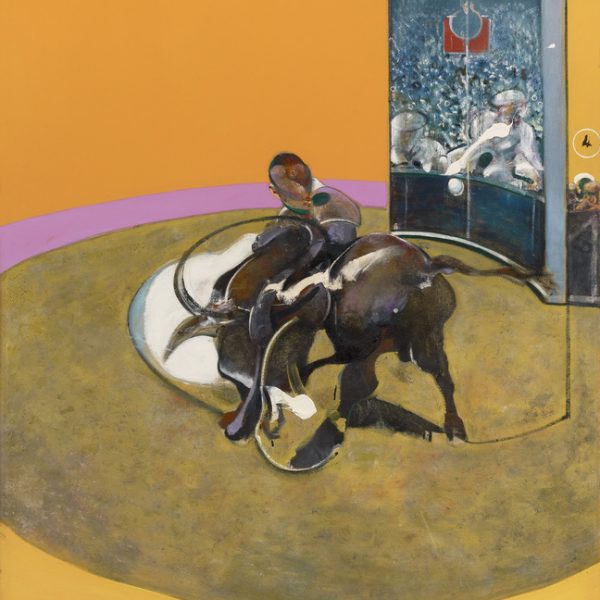
Francis Bacon, Study for Bullfight No. 1, 1969 Oil on canvas, 198 x 147.5cm Private collection © The Estate of Francis Bacon. All rights reserved, DACS/Artimage 2021. Photo: Prudence Cuming Associates Ltd
接下來的部分著眼於培根的愛人與繆斯,還有在培根的作品中最穩定但最神秘的動機 — 復仇女神 ‘Furies’。这里展示了创作于1981年的《 Triptych Inspired by the Oresteia of Aeschylus (以埃斯庫羅斯的奧瑞斯特亞为灵感的三联画)》,這是唯一一幅以这位希腊剧作家命名的作品。在同一展廳里的另外一側被深红色占据的,那是創作於1988年的三聯畫《Second Version of Triptych 1944 (1944年的三聯畫第二版)》,培根再次創作了他在40年代中期的復仇女神主題。
最后展覽以培根創作於1991年,直到2016年才被發現的,生前最後一件作品《Study of a Bull (公牛研究)》 作為結尾。
Edited by Xinde Ren
編輯 x 任心得

